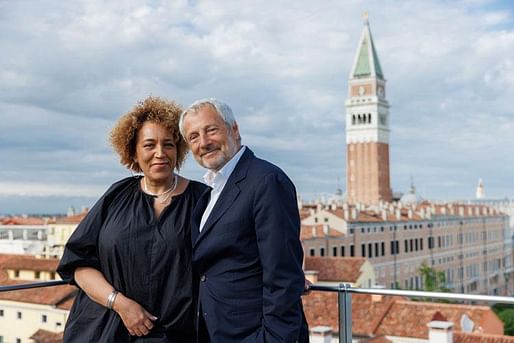

The 18th Venice Architecture Biennale officially announced its 89-strong slate of participants for this year’s exhibition titled “The Laboratory of the Future,” curated by the Scottish-Ghanaian architect and academic Lesley Lokko.
Opening May 20th, the Biennale will run through November 26th and feature an even 50-50 gender parity and the representation of more than half of this year’s participating artists identifying with the African diaspora. The diversity highlighted by the selection underscores the broader theme focused on the social effects of climate change and decolonization while attending to Lokko’s curatorial aim to “put forward ambitious and creative ideas that help us imagine a more equitable and optimistic future in common.”
Theaster Gates, Adjaye Associates, Hood Design Studio, atelier masōmī, and Pritzker-winner Francis Kéré were among those selected to participate in the exhibition. The exhibition is divided into six parts and includes participation from notable studios and design creatives such as Olalekan Jeyifous, Studio Sean Canty, Felecia Davis of SOFTLAB at PSU, Thandi Lowenson, Studio Barnes, and many others. (View the full list of participants in the architecture exhibition category here.)
A total of 46% of participants surveyed said they considered education to be a form of practice, adding to the reimagined platform put forth by Lokko. According to the Biennale, the average age of all participants is 43, with the youngest of participants being 24.
When describing the exhibitions' structure, Lokko explained, “Central to all the projects is the primacy and potency of one tool: the imagination.” She continued, “It is impossible to build a better world if one cannot first imagine it. The Laboratory of the Future begins in the Central Pavilion in the Giardini, where 16 practices who represent a distilled force majeure of African and Diasporic architectural production have been gathered. It moves to the Arsenale complex, where participants in the Dangerous Liaisons section rub shoulders with the Curator’s Special Projects, for the first time a category that is as large as the others. Threaded through and amongst the works in both venues are young African and Diasporan practitioners, our Guests from the Future, whose work engages directly with the twin themes of this exhibition, decolonization and decarbonization, providing a snapshot, a glimpse of future practices and ways of seeing and being in the world.”
“We have deliberately chosen to frame participants as ‘practitioners,” she said in reference to the group, which “And not ‘architects’ and/or ‘urbanists,’ ‘designers,’ ‘landscape architects,’ ‘engineers’ or ‘academics’ because it is our contention that the rich, complex conditions of both Africa and a rapidly hybridizing world call for a different and broader understanding of the term ‘architect,’” explained Lokko.
When describing how the international exhibition will function as an “agent of change,” Lokko spoke on the matter. “What does it mean to be ‘an agent of change’? (…) Over the past nine months, in hundreds of conversations, text messages, Zoom calls and meetings, the question of whether exhibitions of this scale — both in terms of carbon and cost — are justified, has surfaced time and again.”
“In May last year, I referred to the exhibition several times as ‘a story’, a narrative unfolding in space. Today, my understanding has changed. An architecture exhibition is both a moment and a process. It borrows its structure and format from art exhibitions, but it differs from art in critical ways which often go unnoticed. Aside from the desire to tell a story, questions of production, resources, and representation are central to the way an architecture exhibition comes into the world, yet are rarely acknowledged or discussed. From the outset, it was clear that the essential gesture of The Laboratory of the Future would be ‘change.’”
This year’s official U.S. Pavilion will exemplify the environmental focus built into the exhibition with a look at the role of plastic waste in the built environment.
Archinect will have more coverage of the Biennale as events unfold.
No Comments
Block this user
Are you sure you want to block this user and hide all related comments throughout the site?
Archinect
This is your first comment on Archinect. Your comment will be visible once approved.